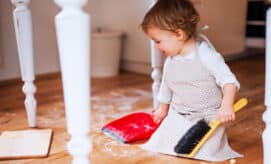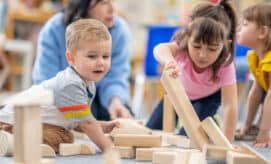Documented learning displays can be hung high on the wall, for parents and teachers/caregivers to refer to, or it can be hung at the children’s eye-level so that they have an opportunity to reflect back on their learning and play.
For more examples of documentation, check out Good2Know Network’s Pinterest board, Documentation & Parent Communication.
The Power of Documentation, during COVID-19 and Beyond
Connection & Communication with Parents
COVID safety requirements have added limitations to the time we can spend chatting with parents during drop-off and pick-up. Creating displays of children’s work and learning can be a way to help parents feel connected to their children’s time in your care. Depending on how you have structured your routines to meet COVID-19 guidelines, you might consider putting your display in a window that parents can see from outside the classroom (as in the photo to the right), or taking photos of your displays and sending them via email so that parents can view them from home. Either way, adding a question for parents to respond to will remind them that you are their partner in their child’s learning and development.
Collaboration with Program Staff
Meeting COVID guidelines can also interfere with the time that teachers and caregivers would typically spend collaborating with one another. Documentation can be a way to share updates about what different groups of children or different classrooms are doing, and encourage educators to build upon one another’s ideas and feel connected to their program’s learning community.
Reflection and Inspiration for Children
When we display documentation at the children’s eye-level, we give them the opportunity to return to their previous ideas and experiences. They are reminded of the past and can create connections with the present. They can also see some of the different ways that their peers were interacting with each other and the environment, encouraging them to learn from each other and themselves. It’s a great way to reinforce the interpersonal skills that are so important in early childhood, despite the need for small groups and social distancing.











